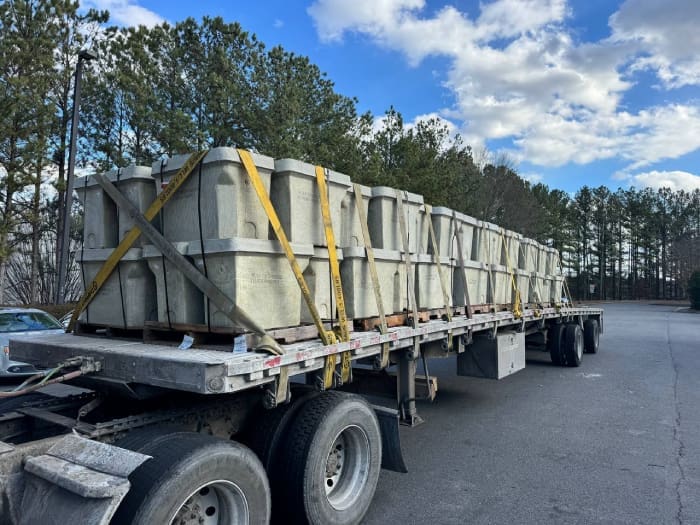Whether it’s moving massive construction machinery or oversized industrial components, flatbed trucks are indispensable for managing complex and heavy-haul logistics.
The demand for these high capacity vehicles is growing steadily due to new infrastructure development projects and increased investments in construction. Flatbed trucks are ideal for transporting heavy gear like steel beams, lumber, and pipelines.
In this article, we explore the ins and outs of flatbed shipping, uncover the types of freight suited for this method of transportation, and delve into the benefits that make it a go-to solution for multiple industries. Next Exit Logistics brokers all types of flatbed shipping, from the difficult to the impossible and is ready to handle your next flatbed transportation job.
What is Flatbed Shipping?
Flatbed shipping involves using trucks equipped with open, flat platforms that lack sides or a roof. This design offers significant flexibility, making it easier to load and unload cargo using cranes, forklifts, or other equipment.
The open design of flatbed trucks allows for the transport of large and unconventional items that would be difficult to fit in standard enclosed trailers.
Types of Flatbed Freight
Heavy haul flatbed trucks are particularly suitable for transporting goods that are oversized, bulky, or do not require coverage.
Types of flatbed truck loads include:
- Oversized and Bulky Items: Items such as construction machinery, large vehicles, and heavy equipment often need the open space provided by flatbed trucks.
- Building Materials: Due to their size and weight, lumber, steel, metals, and other construction materials are commonly transported using flatbeds.
- Specialty Cargo: Pipes, heavy tires, and large machinery also benefit from the ability of flatbed trucks to accommodate loads with large dimensions.
The key advantage of flatbed trucks is their capacity to handle goods that are not easily contained within traditional trailers.
What Industries Use Flatbed Trailers?
Flatbed trailers are crucial across a variety of industries due to their unique capabilities. Some of the common industries relying on flatbed cargo transportation include:
- Construction: For transporting heavy equipment, building materials, and other large items necessary for construction projects.
- Oil and Gas: Moving oversized machinery and materials essential for oil and gas extraction.
- Heavy Machinery: Transporting flatbed loads like large vehicles and industrial equipment that require open, accessible loading spaces.
Flatbed Trailer Types
Flatbed trailers come in various shapes and sizes, each designed to meet specific transportation needs, such as a flatbed partial truckload shipping.
The most common types of flatbed trucks include:
- Lowboy: Ideal for transporting tall flatbed freight loads that need to be closer to the ground for stability and clearance.
- Step Deck: Features a lower deck height compared to standard flatbeds to accommodate taller cargo.
- Stretch Double Drop: Provides extra length and drop sections for very long or heavy items.
- Removable Gooseneck (RGN): Allows for easy loading and unloading of oversized equipment with a detachable front.
- Conestoga: Equipped with a retractable cargo cover that requires protection from the elements.
- Sidekit: Features removable side rails for added flexibility in securing certain types of cargo.
Each trailer type has specific advantages that make them suitable for different kinds of flatbed commodities and logistical requirements. Next Exit Logistics has extensive experience arranging flatbed shipping on all of these types of trailers. Contact us for more information.
FAQs about Flatbed Shipping
What are common flatbed freight items?
Common flatbed freight includes oversized items like construction materials (lumber, steel), heavy machinery, large vehicles, and industrial equipment. Flatbed trucks are ideal for bulky or unconventional loads that require easy access for loading and unloading.
What is the difference between flatbed and LTL shipping?
Flatbed shipping uses open trucks for oversized or bulky items for easy access during loading and unloading. LTL (Less-Than-Truckload) shipping involves consolidating smaller shipments from multiple customers into one truck. This method is ideal for less extensive loads that don’t require an entire truck.
Flatbed Shipping Services with Next Exit Logistics
At Next Exit Logistics, we excel in facilitating flatbed shipping with unparalleled expertise and dedication. We pride ourselves on our proactive communication style which allows us to keep all stakeholders informed for optimal collaboration.
We are energized by excellence and driven to find creative solutions to address your unique challenges. We offer comprehensive services, including meticulous load planning and turnkey services to streamline your shipping process. Our commitment to precision ensures we take exacting measures to ensure the job is done right.
Ready to transform your shipping experience?
Partner with Next Exit Logistics and let us handle your complex shipments with unparalleled care and efficiency.
Contact us today to see how we can make your logistics seamless and stress-free.




